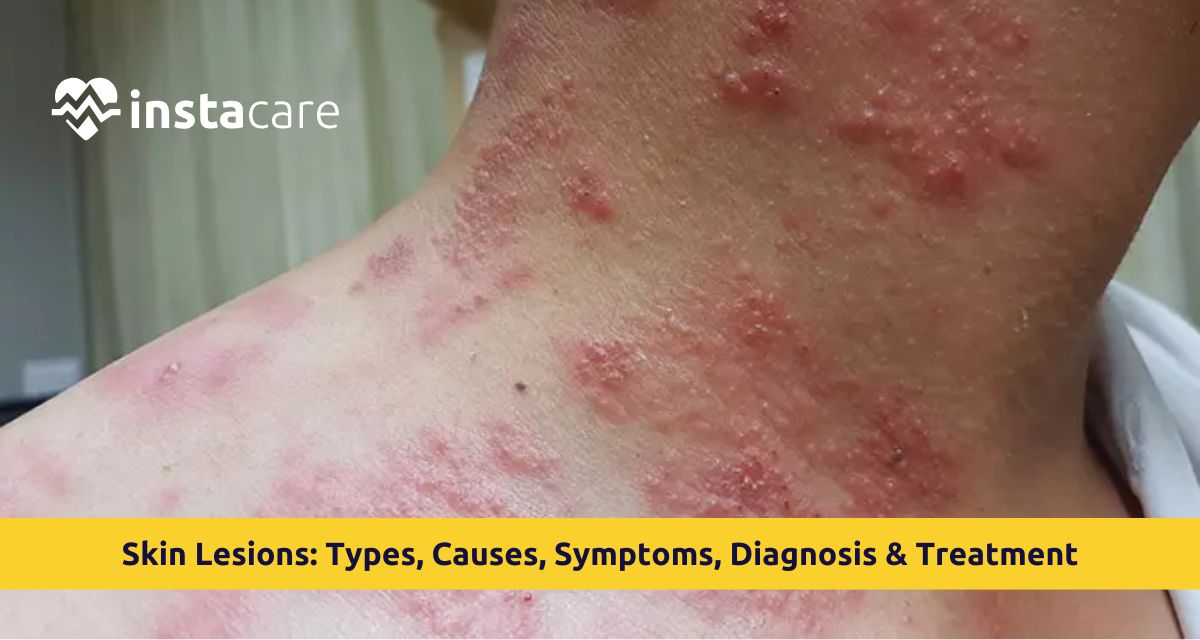What Are Skin Lesions?
- Primary lesions: Secondary to an acute condition or illness (e.g., moles, blisters, acne).
- Secondary lesions: Secondary to alteration or change of a primary lesion (e.g., scarring, ulceration, crusting).
Types of Skin Lesions
Benign Skin Lesions
- Moles (nevi): Brown or black, usually harmless but must be inspected on a change of colour.
- Skin tags: Flapping small growths hanging from the skin which are usually found in folds of skin.
- Cysts: Bladder-like skin spots containing pus or fluid.
- Seborrheic keratoses: Waxy textured skin age spots.
- Cherry angiomas: Red spots as a result of dilated vessels.
2. Malignant Skin Lesions
- Basal Cell Carcinoma: The most common type of skin cancer, usually benign.
- Squamous Cell Carcinoma: Will become malignant if left untreated, displaying the typical appearance of a scaly reddish plaque.
- Melanoma: Malignant skin neoplasm that spreads very quickly; must be diagnosed as early as possible.
- Precancerous skin lesions: An example is actinic keratosis and can progress to squamous cell carcinoma.
The Causes of Skin Lesions
- Allergies: Food, drugs, plants (poison ivy), or cosmetics.
- Autoimmune disorders: Psoriasis or lupus might induce an immune reaction against normal skin.
- Genetic disorders: A few lesions such as moles and tags are genetically determined.
- Age: Areas of skin that become more prone to benign neoplasms and cancers.
- Sunshine: Direct causative factor causing malignancies and precancerous skin lesions.
- Trauma or Wound: A scratch, cut, or a bite could lead to lesions or infected skin lesions.
Read More: 10 Best Lotions for Extremely Dry Skin
Skin Lesions Symptoms
- Redness, swelling, or tenderness
- Itching, burning, or pain
- Crusting or scaling
- Bleeding, oozing, or pus
- Sudden change in size or color
- Irregular shape or asymmetry
Diagnosis of Skin Lesions
Dermatology skin lesion examination
- Physical assessment of lesion and surrounding skin
- Medical and family background
- Examine the lesion with a hand-held magnifying tool such as a dermatoscope.
Skin lesion differential diagnosis
- Skin lesion biopsy
- Suspicious, biopsied
- Tissue or entire lesion excised under local anaesthesia.
Treatment of Skin Lesions
Benign Lesions
- Cryotherapy: Freezing by liquid nitrogen
- Surgical excision: Incision to remove
- Laser ablation: Vascular or pigment lesions
- Electrosurgery: Electric current used for destruction
Infected Skin Lesions
- Local or systemic antibiotics
- Antiviral or antifungal treatment
- Wound care (debridement, dressing, drainage as needed)
Malignant Cutaneous Lesions
- Excision with margin: All cancer cells removed completely
- Mohs surgery: Very exact technique best suited for face or high-risk locations
- Radiation or chemotherapy: Extensive or unresectable disease
- Immunotherapy or targeted therapy: Most notably in melanoma
Surveillance
Prevention Tips
- Use daily sun protection (SPF 30 or higher) and apply every 2 hours when in the sun.
- Stay away from too much sun, including tanning beds.
- Use a hat, sunglasses, and protective clothing when outdoors.
- Inspect your skin monthly for new or changing lesions.
- Have a professional skin checkup yearly by a dermatologist.
- Treat chronic conditions such as eczema or psoriasis.
- Catch it early, especially with precancerous changes in the skin.
Conclusion

